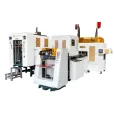Oct. 21, 2025
Rigid boxes, also known as gift boxes or luxury packaging boxes, are widely used for premium products such as electronics, jewelry, cosmetics, and perfumes. They are known for their sturdy structure and high-end appearance. But have you ever wondered how these boxes are made? Let’s explore how a rigid box making machine works and what happens during each stage of the production process.
A rigid box making machine is an automated piece of equipment designed to assemble high-quality, hard boxes with precision and speed. It integrates several processes—paper wrapping, gluing, positioning, and forming—into a single production line. Depending on the model, these machines can handle everything from semi-automatic to fully automatic operations.
The process starts with feeding the printed and laminated cover paper (outer wrapping) into the machine. An automatic feeder aligns and positions each sheet accurately. High-precision cameras or sensors ensure that the paper is perfectly registered before the next step.
The machine applies an even layer of hot or cold glue onto the backside of the cover paper. The glue coating must be uniform to prevent wrinkles or bubbles when wrapping. Some advanced machines use adjustable glue rollers to control the thickness and area of glue application.

Next, the inner greyboard (also called chipboard) that forms the rigid structure is fed into the machine. These boards are pre-cut into panels—usually one base and four sides—according to the box size. A robotic arm or positioning unit accurately places these boards onto the glued paper.
Once the boards are in place, the machine folds the edges of the wrapping paper around the board. This step creates the clean, smooth corners that make rigid boxes look professional. The wrapping is done under pressure to ensure tight bonding and eliminate air bubbles.
In the forming section, the bottom or top part of the box is pressed and shaped using forming molds. The forming unit applies pressure and heat (if required) to create the final rigid structure. This step ensures the box has sharp edges and a precise shape.
After forming, the boxes are transferred to a drying or pressing station to stabilize the adhesive. The finished boxes are then stacked neatly, ready for quality inspection and packaging.
Feeding System: For automatic paper and board feeding.
Gluing System: Ensures consistent adhesive application.
Positioning Unit: Aligns paper and board precisely using cameras.
Folding & Wrapping System: Folds edges cleanly for seamless appearance.
Additional resources:Box Forming Mold: Shapes the box with accuracy and uniformity.
Control Panel: Allows operators to adjust settings, speed, and size parameters.
Semi-Automatic Rigid Box Machines: Require manual positioning and folding; ideal for small-scale production.
Fully Automatic Rigid Box Machines: Perform all steps automatically; suitable for mass production and high-end packaging lines.
Corner Pasting Machines: Used in combination with rigid box machines for assembling box frames before wrapping.
High Efficiency: Automates multiple steps, greatly improving productivity.
Precision and Consistency: Ensures each box meets exact specifications.
Premium Finish: Produces smooth edges, firm corners, and luxury appearance.
Reduced Labor Costs: Minimizes manual intervention and error.
Customization: Supports different box shapes, sizes, and materials.
A rigid box making machine transforms simple paper and board materials into elegant, durable packaging with remarkable speed and precision. From feeding and gluing to forming and stacking, each stage is designed to ensure accuracy and efficiency. For manufacturers in the luxury packaging industry, investing in a high-quality rigid box making machine is essential to achieving both scalability and superior product presentation.
Previous: The Future of the Intelligent Fully Automatic Rigid Box Making Machine
Next: Comparando Máquina Formadora de Bandejas para Bolos e Outros Equipamentos
If you are interested in sending in a Guest Blogger Submission,welcome to write for us!
All Comments ( 0 )